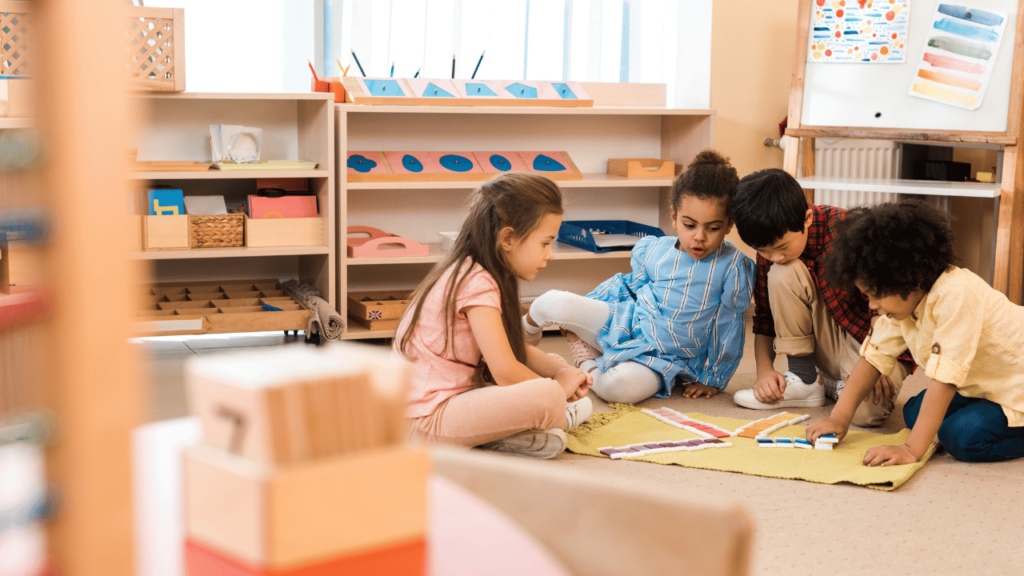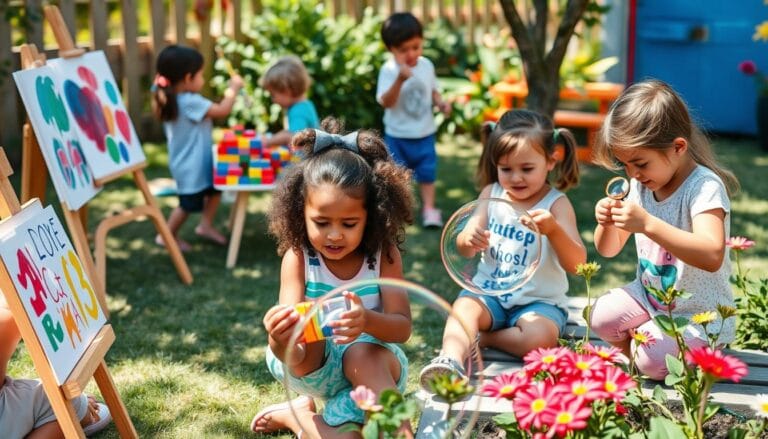
Learn Video Game Design Basics for Kids
Video games have become a popular form of entertainment for children, captivating their imaginations and providing endless hours of fun. But have you ever wondered how these games are created? In this article, we will dive into the fascinating world of video game design basics for kids, exploring the process of game development and how children can unleash their creativity to build their own games.
Whether your child dreams of designing the next big hit or simply wants to express their ideas through game creation, learning the fundamentals of video game design can be a valuable and enjoyable experience.
Key Takeaways:
- Video game design basics for kids offer a creative outlet for their ideas and imaginations.
- Understanding the process of game development is crucial for beginners in game design.
- Game development classes can provide structured learning opportunities and guidance for kids interested in creating their own games.
- Game development fosters critical skills such as problem-solving, logical reasoning, and coding.
- By following the stages of game development, kids can create successful and engaging games of their own.
How Video Games Work
Understanding how video games work is essential for beginners in game design. By delving into the concept and framework of video games, young game designers can develop a strong foundation for creating their own games. This section will break down the process of creating a video game, covering important topics such as planning, outlining, storyboarding, and team collaboration. By grasping these fundamental principles, kids will gain a deeper understanding of video game mechanics and the overall game development process.
The Video Game Development Process
The process of developing a video game involves several key steps that contribute to creating an immersive and engaging gaming experience. Let’s explore each stage:
- Planning: At the beginning of the process, game designers brainstorm ideas, define the game’s core mechanics, and establish the overall vision and goals.
- Outlining: Once the core mechanics are determined, designers create a detailed outline, including the game’s storyline, characters, settings, and levels.
- Storyboarding: In this phase, designers visually map out the game’s sequence of events, transitions, and gameplay elements.
- Gathering a Team: Game development often requires a collaborative effort. Designers may work with programmers, artists, sound designers, and other professionals to bring the game to life.
- Creating Assets: Artists and graphic designers create the visual assets, including characters, environments, objects, and animations.
- Coding: Programmers write the code that brings the game mechanics and interactions to life, implementing features such as player controls, enemy behavior, and game physics.
- Testing: Quality assurance testers playtest the game, identifying bugs, glitches, and other issues that need to be resolved.
- Refinement: Based on feedback from testers, designers refine and polish the game, making necessary adjustments and improvements.
- Release: Once the game is complete, it can be released on various platforms, such as consoles, computers, or mobile devices, for players to enjoy.
By understanding the intricacies of the game development process, kids can develop a solid foundation for creating their own games. The hands-on experience gained from planning, storyboarding, and collaborating with a team will enhance their skills and creativity, setting them on a path to become proficient game designers.
Game Development Classes for Kids
When it comes to learning game design, game development classes are a fantastic option for kids. These classes offer structured programs that provide kids with the necessary skills and techniques to create their own games. Not only do they provide valuable knowledge, but they also foster creativity, problem-solving abilities, and teamwork.
Game development classes are highly effective in teaching kids the fundamentals of game design. Through hands-on projects, interactive lessons, and expert guidance, kids can explore the world of game development in a fun and engaging way. These classes empower children to unleash their creativity, develop critical thinking skills, and build their technical proficiency.
One standout example of game development classes for kids is Create & Learn’s game design classes. Create & Learn offers online courses that cater specifically to young learners. These classes provide a comprehensive curriculum that covers everything from game design principles to coding and programming. With personalized projects and project-based learning, students can apply their learning in practical settings.
Benefits of Game Development Classes
Enrolling in game development classes for kids brings several benefits, including:
- Structured learning: Game development classes provide a structured curriculum that guides kids through the game creation process, ensuring they learn the necessary skills in a logical sequence.
- Hands-on experience: These classes offer hands-on projects and assignments that allow kids to apply what they learn and develop practical skills.
- Collaborative learning: Many game development classes encourage teamwork and collaboration, fostering essential skills such as communication, teamwork, and problem-solving.
- Industry insights: Expert instructors in game development classes can provide valuable industry insights, sharing their experiences and knowledge with young game designers.
- Career preparation: Game development classes introduce kids to the various career opportunities in the gaming industry, helping them explore their interests and passions.
Overall, game development classes for kids offer a structured and supportive environment where they can learn and grow as aspiring game designers. These classes equip children with the skills and knowledge they need to create their own games and set them on a path towards a rewarding future in the world of game development.
| Game Development Classes | Description | Features |
|---|---|---|
| Create & Learn | Create & Learn provides online game design classes for kids, offering a comprehensive curriculum that covers game design principles, coding, and project-based learning opportunities. |
|
| Code.org | Code.org offers game development courses designed for kids, teaching them the basics of computer science and game design through interactive lessons and coding activities. |
|
| Unity Learn | Unity Learn provides a variety of game development courses for kids, ranging from beginner-level courses to advanced tutorials, covering topics such as 2D and 3D game design, animations, and more. |
|
Importance of Game Development for Children
Game development is not just about entertainment; it also offers numerous benefits for children’s development and learning. Engaging in game development activities can foster critical skills such as analytical thinking, problem-solving, logical reasoning, and coding.
Through the process of creating their own games, children learn to think strategically, analyze situations, and come up with creative solutions. They develop the ability to break down complex problems into smaller, more manageable parts, enhancing their problem-solving skills both inside and outside the gaming realm.
Furthermore, game development introduces children to STEM (Science, Technology, Engineering, and Mathematics) concepts at an early age. They learn to apply scientific and mathematical principles in a practical and engaging manner. This hands-on approach encourages a deeper understanding of these subjects and sparks curiosity for further exploration.
Game development also nurtures children’s creativity and storytelling abilities. As they design characters, write narratives, and build game worlds, they have the opportunity to express their imagination and develop their storytelling skills. Creating their own games allows children to become active participants in the creative process, empowering them to bring their unique ideas to life.
Additionally, game development cultivates design thinking skills. Children learn to consider user experience, interface design, and overall game flow, refining their ability to create intuitive and engaging experiences for players. This skillset is transferable to various fields, such as graphic design, user experience design, and product development.
The following table highlights some of the key skills children can develop through game development:
| Skill | Benefit |
|---|---|
| Analytical thinking | Enhances problem-solving abilities |
| Logical reasoning | Develops structured thinking and decision-making skills |
| Coding | Introduces the fundamentals of programming and computational thinking |
| STEM concepts | Offers practical application of science and mathematics concepts |
| Creativity | Fosters imaginative thinking and self-expression |
| Storytelling | Enhances narrative skills and creativity in storytelling |
| Design thinking | Promotes user-centric design and problem-solving |
By engaging in game development, children acquire a range of skills that are invaluable in today’s technology-driven world. They develop a solid foundation in STEM concepts, critical thinking, and creativity, which can potentially pave the way for future career opportunities in fields such as game design, software development, and digital media.
Next, we will explore the stages of game development for kids, providing a comprehensive overview of the journey from concept to a fully realized game.
Stages of Game Development for Kids
Game development for kids involves a step-by-step process that guides them through each stage of creating their own games. Understanding these stages is essential for kids to navigate the game development process and build successful and engaging games. Let’s explore the various stages of game development for kids:
1. Ideation and Creation
In this initial stage, kids brainstorm ideas for their game and create a clear concept. They define the game’s theme, characters, and objectives, and outline the gameplay mechanics. This is a crucial step where creativity and imagination come into play.
2. Planning and Design
Once kids have a clear concept, they move on to planning and designing their games. They create storyboards, develop level layouts, and design the visual elements of their game using software tools or pen and paper. This stage allows kids to flesh out their ideas and craft a solid foundation for their game.
3. Development and Programming
After planning, kids can begin the actual development process. They learn programming fundamentals and use coding languages or visual scripting tools to bring their games to life. This stage involves implementing the gameplay mechanics, creating the game’s environment, and integrating audio and visual elements.
4. Testing and Refinement
Once the game is developed, kids enter the testing phase. They playtest their games to identify any bugs, glitches, or areas that need improvement. Feedback from friends, family, or fellow game developers can be invaluable in refining the gameplay, addressing technical issues, and enhancing the overall user experience.
5. Polishing and Finalization
After addressing the feedback and making necessary improvements, kids focus on polishing their games. They refine the game’s graphics, sound effects, and user interface, ensuring a visually appealing and immersive experience for players. This stage is crucial for adding the final touches and perfecting the game before its release.
6. Release and Sharing
The final stage of game development for kids is the release and sharing of their games. They can publish their games on platforms like app stores, websites, or share them with friends and family. This stage provides an opportunity for kids to showcase their creations and receive feedback from a wider audience.
By understanding and following these stages of game development, kids can unleash their creativity, learn valuable skills, and create games they can be proud of.
| Stage | Description |
|---|---|
| Ideation and Creation | Brainstorming game ideas, defining concepts, and outlining gameplay mechanics. |
| Planning and Design | Creating storyboards, level layouts, and designing the visual elements of the game. |
| Development and Programming | Implementing gameplay mechanics, coding, and creating the game’s environment. |
| Testing and Refinement | Playtesting, identifying and fixing bugs, and improving the overall user experience. |
| Polishing and Finalization | Refining graphics, sound effects, and user interface to enhance the game’s quality. |
| Release and Sharing | Publishing the game and sharing it with others to receive feedback and showcase creativity. |
Note: The duration of each stage may vary depending on the complexity of the game and the individual’s learning pace.
Conclusion
Video Game Design Basics for Kids Encouraging kids to learn video game design basics can be a rewarding experience that enhances their creativity, problem-solving skills, and understanding of technology. By following the step-by-step guide discussed in this article, kids can unlock their potential and create their own games. Whether they choose to take game development classes, use game development tools, or explore game design independently, the possibilities are endless.
Game design is an exciting opportunity for kids to express their ideas and bring their imagination to life. Through creating their own games, kids can develop essential skills such as critical thinking, logical reasoning, and coding knowledge. They can also explore storytelling, design thinking, and collaboration as they work on game projects.
With the right resources and support, kids can easily embark on their game design journey. There are online game development courses, like Create & Learn’s game design classes, specifically tailored for kids. These classes provide project-based learning opportunities and personalized projects, ensuring a fun and engaging learning experience. So, whether your child dreams of becoming a game designer or simply wants to explore their creativity, game design offers a platform for them to learn, grow, and enjoy the process.
FAQ
What are the basics of video game design for kids?
Video game design basics for kids involve understanding the process of game development, from planning and outlining to gathering a team and choosing the right software. Additionally, kids can gain inspiration from existing games to help with their own game creation.
How do video games work?
Video games work by following a specific framework and concept. This includes planning, outlining, storyboarding, and gathering a team. By understanding these fundamentals, kids can create their own games.
Are there classes available for kids to learn game development?
Yes, game development classes can be an excellent way for kids to learn the necessary skills and techniques for creating their own games. Programs like Create & Learn’s game design classes offer project-based learning opportunities and personalized projects for students.
Why is game development important for children?
Game development offers numerous benefits for children, including the development of critical skills such as analytical thinking, problem-solving, logical reasoning, and coding. It also introduces kids to STEM concepts and fosters creativity, storytelling, and design thinking.
What are the stages of game development for kids?
The stages of game development for kids include ideation, creation, testing, and release. This involves planning and designing the game, refining and polishing it, and then sharing it with others.
How can kids learn video game design basics?
Encouraging kids to learn video game design basics can be a rewarding experience that enhances their creativity, problem-solving skills, and understanding of technology. They can take game development classes, use game development tools, or explore game design independently.













